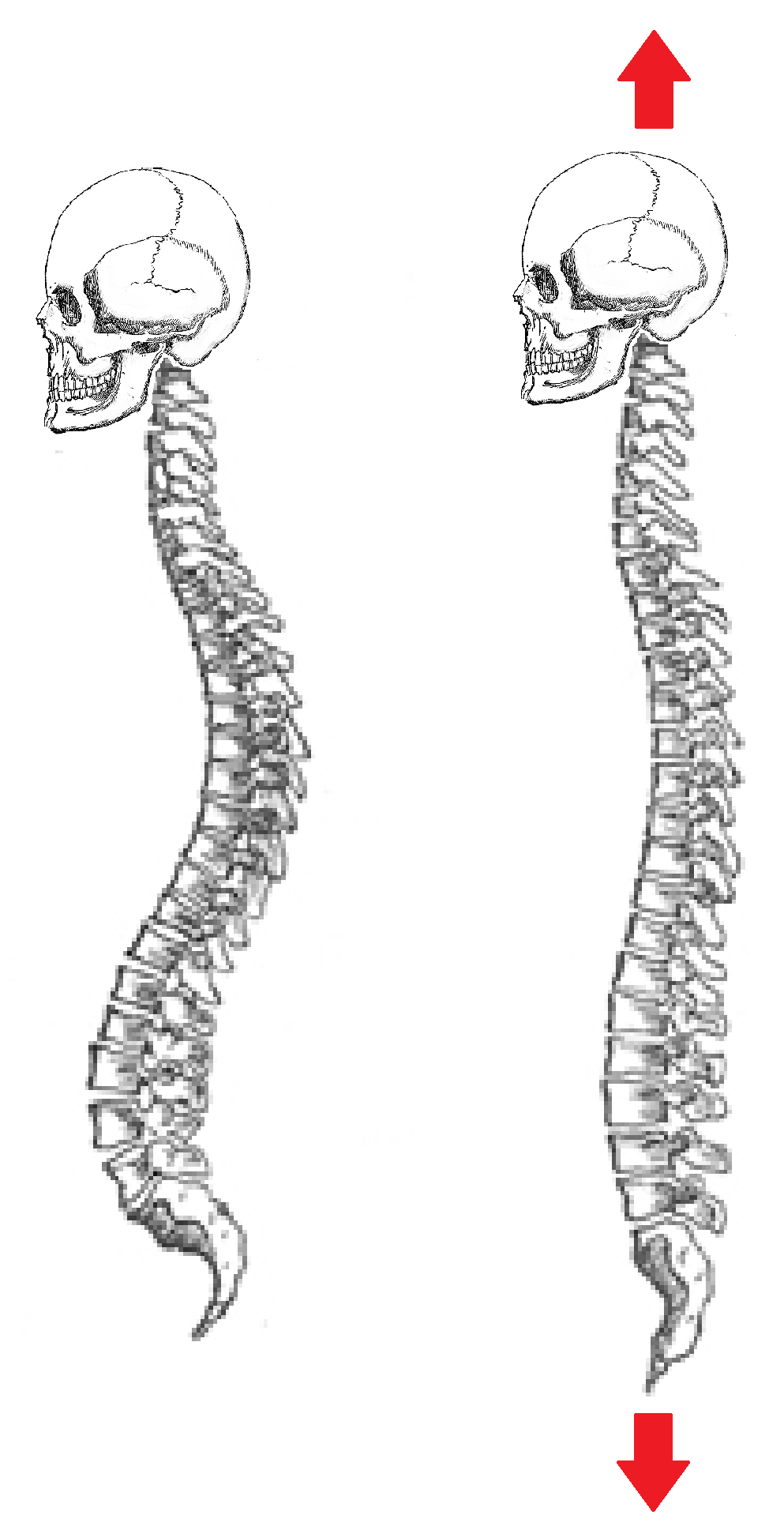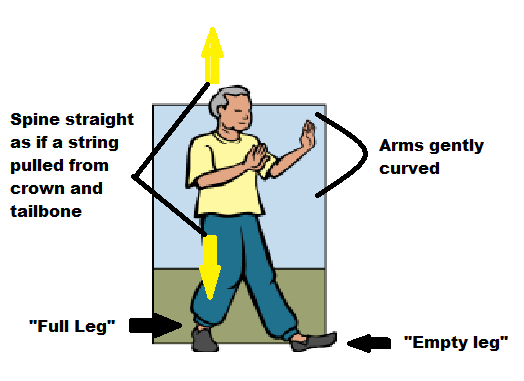
- Dr. Gryffin
Tai Chi is becoming a popular exercise, resulting in a wide range of teaching methods. Some changes are beneficial, but others may reduce or even eliminate the unique benefits of Tai Chi. This page shows what to look for in a Tai Chi class to maximize the benefits of Tai Chi for health.
It is critical to know the details of the form of Tai Chi being practiced – many contradictory results in research studies may be due to different forms of Tai Chi being used, different forms of instruction, or a long learning curve (the latter being the reason I developed the Tai Chi Group Follow-Along Form).
There are many colorful histories and legends regarding the origins of Tai Chi, but the essence of the philosophy behind the slow spiraling movements lies in its origin as a martial art. The slow movements permitted a level of mastery over muscle tension that allowed more efficient use of muscular power, as well as increased sensitivity in controlling the movements of a “stiffer” opponent. The person who was more relaxed could feel the tension in the other person, allowing anticipation of movements and greater control over the person. Tai Chi Chuan literally translates as “Grand Ultimate Fist,” due to its effectiveness in combat when practiced as a martial art.
As such Tai Chi became a valuable health exercise as well, since removing tension in the body has many valuable health benefits, including increased blood circulation, impacting every health function in the body. Since this is also the goal of many Qi Gong exercises, Tai Chi has become classified as a form of Qi Gong. Qi literally translates as “Oxygen,” and “Gong” as “Excellence,” or in other words, a breathing exercise to maximize oxygen intake and oxygen based metabolism.
Recent research indicates that the slow movements of Tai Chi relaxes the muscles and decreases oxygen demand by the large muscle groups, resulting in an increase in blood oxygen saturation. Many of the benefits documented throughout this site may be due to the increase in blood oxygen saturation. To enhance blood oxygen saturation, Tai Chi needs to follow a few key steps.
TAI CHI is characterized by slow relaxed movements. Faster practice of Tai Chi may result in some aerobic benefit, but will not result in the unique action on the body that results from a dynamic state of relaxation, coupled with deep slow breaths. On the other hand, movements that are too slow may minimize blood oxygen saturation, as the body uses up the blood oxygen supply faster than it can be replaced. The key is to coordinate breathing with movement so each breath is deep and even, slow enough to maximize blood oxygen diffusion, but not so slow that oxygen is removed from the blood faster than it is replenished.
THE BREATH AND PACE IN TAI CHI
A pace of approximately seven to eight minutes for the 24 short form, or 25 to 35 minutes of practice for the 108 Yang style long form, may maximize blood oxygen saturation. Differences may occur based on a person’s level of fitness. If you are completing several movements with one breath, slow down each movement to match the breath. The goal is to completely fill the lungs at the beginning of each movement, and completely empty the lungs at the end of each movement, as slowly as possible without feeling short of breath. If you feel you are running out of breath when going slow, speed up the movements.
For martial practice, slower and faster paces may be used to train the body for specific applications (faster for balance, force, and aerobic conditioning; slower for greater relaxation of muscle tension, to maximize sensitivity in controlling an opponent and to maximize strength), but for health purposes the above guidelines have demonstrated the greatest increase in blood oxygen saturation.
BEING “SINGLE WEIGHTED”
Another key element to maximize diffusion of the blood and oxygen throughout the body, as well as to develop a greater level of relaxation in the mind and body, relates to the way the weight is carried by the legs. During almost every movement in Tai Chi, the goal is to be “single weighted,” that is, the weight of the body is essentially balanced entirely over one leg or the other, shifting back and forth as a person transitions through the movements. When the weight of the body is balanced equally between the legs, this results in being “double weighted.” The reason for being single weighted lies in the martial origins of Tai Chi, but the practical effect for health is that by letting the weight of the body shift entirely to one leg (for example the right leg), the rest of the body can be allowed to relax entirely – the left leg, the hips, the torso, shoulders, arms, neck and head. This enhances blood diffusion, and muscular relaxation. As the movement transitions through to the opposite leg (for example, the left leg), the other side relaxes.
An analogy is often made of the idea of imagining one leg being “full” of water, and the water “pouring” into the “empty” leg as one shifts through to the next movement, until the full leg becomes empty, and the empty leg becomes full. This transition of empty and full occurs throughout the entire form. Essentially Tai Chi is the act of balancing on one leg and then the other, while relaxing the opposite leg and the entire body. This is the reason Tai Chi is such a valuable exercise for enhancing balance. The below link will take you to a video demonstrating the “three step” Tai Chi walking exercise demonstrating the above principles:
https://www.youtube.com/watch?v=NRrSiDtFGio
Weighting one leg also increases the heart rate slightly, stimulating blood flow throughout the body more so than if the form were practiced in a standing position.
EXTENDING THE SPINE
One other critical element is the positioning of the spine during Tai Chi. As the movements are performed, the practitioner tucks the tailbone and extends the neck, as if a string were being pulled from the crown of the head and the tip of the tailbone. This releases muscle tension in the shoulders and lower back, straightens the spine, and maximizes spinal rotation and adjustment. It is important not to strain or overdo the straightening of the back, particularly in the beginning, to prevent back strain from unfamiliar positions, or movement beyond the range of motion for your body.
Aside from slow relaxed movements, deep breathing, and a straight spine, a few other details should be kept in mind. The knees should be bent slightly, to elevate the heart rate while keeping relaxed. The bent kneed almost crouched position has the added benefit of strengthening the knees. But it is important to keep the knees from bending too far, which can result in knee strain and injury. A good preliminary guideline is to prevent the knees from extending beyond the toes, keep aware of the bodies signals, and as with any element of Tai Chi, consult with a doctor if in doubt.
To maximize relaxation in the arms and shoulders, let the shoulders relax, the hands (except in specific instances such as “crane spreads its wings”) never rising above the nose, nor extending totally straight. In most movements the arms are bent and curved, as if hugging a beach ball. Over extending results in tension. The hands should be relaxed as well, with perhaps a slight counter tension pressing down to counteract years of gripping the hands in stress and tension (sources differ on recommendations to press down. I vary between the two depending on my mood). If you stand with your hands relaxed at your sides, and they curl inward like claws, this is the result of years of tension. The tension in the hands can be stretched out and relaxed by pressing down as if on an invisible table during the form.
The actual movements may be less critical than the method of relaxed shoulders, arms, and body, with a straight spine, bent knees, and slow relaxed and deep breaths (unless one is practicing Tai Chi as a martial art). Removing tension from the body, enhancing oxygen saturation, while relaxing and calming the mind, are the key goals of Tai Chi for health.


 RSS Feed
RSS Feed